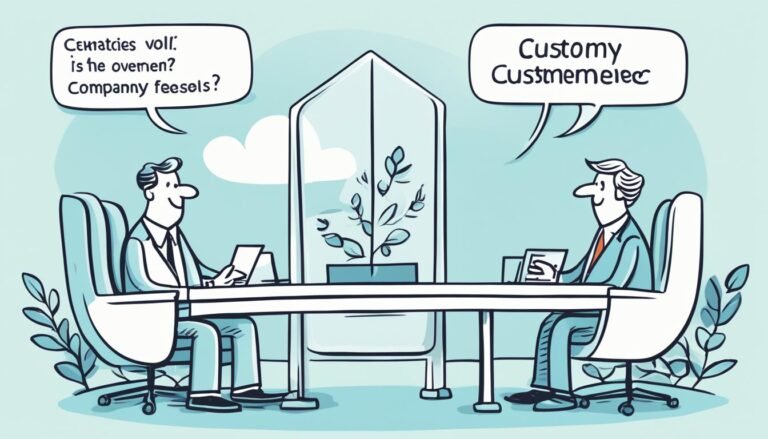Mastering Customer Lifecycle in Sales Guide
Customer lifecycle management is a crucial aspect of sales success. It involves understanding the customer journey and implementing strategies to effectively engage and retain customers. In this guide, we will explore the different stages of the customer lifecycle, such as customer acquisition, onboarding, engagement, retention, and advocacy. By mastering the customer lifecycle, businesses can optimize their sales funnel stages, improve customer satisfaction, and drive lasting loyalty.
Key Takeaways:
- Understanding the customer journey is key to effective customer lifecycle management.
- The customer lifecycle consists of various stages, including acquisition, onboarding, engagement, retention, and advocacy.
- By focusing on each stage of the customer lifecycle, businesses can optimize their sales funnel and drive customer loyalty.
- Customer behavior analysis is essential for tailoring personalized experiences and enhancing customer satisfaction.
- Sales pipeline management and conversion rate optimization play a significant role in maximizing sales success.
What is Customer Lifecycle Management?
Customer lifecycle management is a strategic approach that involves understanding and managing the journey that customers go through with a brand. It encompasses analyzing customer behavior, identifying key touchpoints, and implementing strategies to enhance customer satisfaction and drive sales opportunities.
By carefully managing the customer lifecycle, businesses can maximize customer retention and create personalized experiences that lead to lasting loyalty. This not only boosts customer satisfaction but also increases the likelihood of repeat purchases and positive word-of-mouth recommendations.
At the heart of customer lifecycle management is understanding customer behavior. By analyzing data and customer interactions, businesses can gain valuable insights into customer preferences, needs, and pain points. This enables them to tailor their offerings, marketing messages, and overall customer experience to effectively meet customer expectations.
Customer satisfaction is a key driver of success in customer lifecycle management. By providing exceptional customer service and support, businesses can ensure that customers feel valued and cared for. This not only increases customer satisfaction but also fosters a sense of trust and loyalty, leading to long-term relationships with customers.
Furthermore, customer lifecycle management identifies various sales opportunities throughout the customer journey. By leveraging customer data and insights, businesses can identify upselling and cross-selling opportunities, resulting in increased sales revenue and customer lifetime value.
Overall, customer lifecycle management allows businesses to optimize their customer retention strategies, create meaningful and personalized experiences, and ultimately build strong relationships with their customers. By implementing effective customer lifecycle management practices, businesses can drive long-term success and achieve sustainable growth.
The Importance of Customer Lifecycle Management
Customer lifecycle management plays a crucial role in the success of businesses, as it directly impacts revenue generation. By understanding the different stages of the customer journey and delivering personalized experiences, businesses can enhance customer satisfaction, boost customer retention, and ultimately drive customer loyalty.
A well-executed customer lifecycle management strategy allows businesses to maximize the lifetime value of their customers, creating a strong foundation for long-term success.
Enhancing Customer Satisfaction
By focusing on each stage of the customer journey, businesses can identify and address the specific needs and pain points of their customers. This personalized approach to customer lifecycle management enhances customer satisfaction and increases their overall experience with the brand.
When customers feel valued and well-cared for throughout their journey, they are more likely to remain loyal and continue purchasing products or services from the business.
Boosting Customer Retention and Loyalty
Customer lifecycle management allows businesses to implement strategies to proactively engage customers and nurture the relationship over time. By understanding customer behavior and preferences, businesses can tailor their offerings and communications to match each customer’s needs.
Building a strong relationship with customers fosters trust and loyalty, encouraging repeat purchases and long-term commitment. Customers who feel a connection with a brand are more likely to become brand advocates, sharing positive experiences with others and driving additional revenue through referrals.
| Benefits of Customer Lifecycle Management |
|---|
| Optimized revenue generation |
| Increased customer satisfaction |
| Boosted customer retention |
| Strengthened customer loyalty |
By prioritizing customer lifecycle management, businesses can create a positive and seamless experience for their customers, leading to sustainable revenue growth and a loyal customer base.
With a well-designed customer lifecycle management strategy, businesses can confidently navigate the customer journey, driving customer satisfaction, loyalty, and long-term success.
The Five Stages of the Customer Lifecycle
The customer lifecycle encompasses five key stages: acquisition, onboarding, engagement, retention, and advocacy. Each stage plays a crucial role in nurturing customer relationships and driving business growth.
Acquisition
In the acquisition stage, businesses focus on attracting and converting leads into customers. This involves implementing effective marketing strategies and sales tactics to generate interest and encourage prospects to make a purchase. Key activities during this stage include lead generation, lead qualification, and closing the initial sale.
Onboarding
Once a customer is acquired, the onboarding stage kicks in. This stage is all about making a positive first impression and setting the foundation for a strong customer relationship. Businesses need to provide a smooth and seamless onboarding experience, guiding new customers through the product or service and familiarizing them with its features and benefits. Effective onboarding establishes trust and helps customers understand how to get the most value from their purchase.
Engagement
Engagement is a continuous process aimed at maintaining and strengthening the relationship with existing customers. It involves proactive communication, ongoing support, and personalized interactions to keep customers engaged and satisfied. Businesses can nurture engagement through targeted email campaigns, social media interactions, personalized recommendations, and proactive customer support. By consistently delivering value, businesses can foster loyalty and increase customer lifetime value.
Retention
The retention stage focuses on strategies to retain customers and enhance their loyalty. It involves providing exceptional customer experiences, addressing any concerns or issues promptly, and continually delivering value. By implementing loyalty programs, offering exclusive benefits, and seeking feedback, businesses can strengthen the bond with customers and reduce churn. Retaining customers is essential as it is generally more cost-effective than acquiring new ones and can lead to positive word-of-mouth referrals.
Advocacy
The advocacy stage is where satisfied customers become brand advocates and actively promote the business to others. Advocacy can take various forms, such as recommending the product or service to friends and colleagues, leaving positive reviews or testimonials, or even participating in referral programs. Businesses can encourage advocacy by fostering a strong customer community, providing incentives for referrals, and continuously delivering exceptional experiences. Brand advocates not only contribute to customer acquisition but also help build a positive brand image and attract new customers.
Understanding and effectively managing each stage of the customer lifecycle is crucial for businesses to build strong customer relationships, drive customer satisfaction and retention, and ultimately achieve long-term success.
Calculating Customer Lifetime Value (CLV)
Customer lifetime value (CLV) is a crucial metric in understanding the long-term revenue potential of a customer. By evaluating factors such as customer retention, repeat purchases, and average transaction value, businesses can gain valuable insights into the value each customer brings to their bottom line. Calculating CLV allows businesses to tailor their marketing and sales strategies to maximize the return on investment from each customer.
CLV is determined by considering the revenue generated by a customer throughout their entire relationship with a business. This metric provides a comprehensive view of the customer’s contribution to the company’s financial success, taking into account both the initial acquisition cost and the ongoing revenue generated.
Factors influencing Customer Lifetime Value
- Customer Retention: A crucial component of CLV is the ability to retain customers over an extended period. High customer retention rates contribute to a higher CLV as it means customers continue to make repeated purchases, increasing their overall value to the business.
- Repeat Purchases: Customers who make frequent purchases have a higher CLV as their continued loyalty brings in consistent revenue. Encouraging repeat purchases through targeted marketing campaigns and customer loyalty programs can significantly impact CLV.
- Average Transaction Value: The average value of each customer transaction directly affects CLV. By encouraging customers to make larger purchases or upselling additional products or services, businesses can increase the average transaction value and subsequently raise CLV.
Calculating the CLV involves analyzing customer data, including purchase history, customer behavior, and average sales data. By understanding the various factors that influence CLV, businesses can develop strategies to improve customer retention, increase repeat purchases, and ultimately elevate the overall CLV of their customer base.
| CLV Calculation | Formula |
|---|---|
| Customer Lifetime Value | (Average Transaction Value x Number of Transactions per Year) x Average Customer Lifespan |
| Acquisition Cost | Total Marketing and Sales Expenses / Number of New Customers |
| CLV to Customer Acquisition Cost Ratio | Customer Lifetime Value / Acquisition Cost |
Understanding and optimizing CLV is crucial for businesses looking to maximize their long-term revenue potential. By identifying high-value customers, nurturing customer relationships, and implementing effective retention strategies, businesses can not only increase their bottom line but also cultivate a loyal customer base with a higher CLV.
Mastering Customer Lifecycle Management Strategies
To excel in customer lifecycle management, businesses need to implement effective strategies at each stage of the customer journey. This involves delivering personalized experiences, enhancing customer satisfaction, and aligning marketing and sales efforts. By mastering these strategies, businesses can optimize the customer lifecycle and drive long-term success.
- Targeted Marketing Campaigns: Tailor marketing messages and content to specific customer segments, ensuring relevance and maximizing engagement.
- Onboarding Programs: Provide a seamless onboarding experience that educates customers about your products or services and sets them up for success.
- Customer Support Initiatives: Offer prompt and efficient customer support to address queries, resolve issues, and reinforce positive experiences.
- Loyalty Programs: Implement loyalty programs to reward and incentivize repeat purchases, fostering customer loyalty and brand advocacy.
- Proactive Engagement: Regularly engage with customers through personalized interactions, such as personalized emails, social media engagement, and exclusive offers.
By leveraging these strategies, businesses can build stronger relationships with customers, enhance customer satisfaction, and increase the likelihood of repeat purchases and brand advocacy. Additionally, aligning marketing and sales efforts ensures a consistent and cohesive customer experience throughout the entire customer lifecycle.
Case Study: Personalized Email Campaigns
In a recent study, Company XYZ successfully implemented personalized email campaigns as part of their customer lifecycle management strategy. By utilizing customer data and segmentation, they tailored their email content to individual preferences and behaviors.
“Personalized emails were a game-changer for us. We saw a significant increase in email open rates and click-through rates. Our customers appreciated the relevant content and felt more connected to our brand. As a result, we noticed a boost in customer satisfaction and an increase in sales.”
The success of the personalized email campaigns highlights the power of delivering personalized experiences at various touchpoints in the customer journey. It demonstrates how customer lifecycle management strategies can positively impact customer satisfaction, engagement, and ultimately, revenue growth.
| Benefits of Mastering Customer Lifecycle Management Strategies |
|---|
| Increased customer satisfaction |
| Enhanced customer engagement |
| Improved customer retention |
| Higher conversion rates |
| Maximized customer lifetime value |
| Strengthened brand loyalty and advocacy |
Mastering customer lifecycle management strategies is crucial for businesses that aim to deliver personalized experiences, enhance customer satisfaction, and optimize marketing and sales efforts. By implementing targeted marketing campaigns, onboarding programs, customer support initiatives, loyalty programs, and proactive engagement, businesses can foster stronger customer relationships and drive long-term success.
Leveraging EngageBay for Customer Lifecycle Management
EngageBay is an exceptional CRM platform that empowers businesses to effectively achieve their customer lifecycle management goals. With a wide range of tools and features, EngageBay enhances customer engagement, streamlines the customer journey, and drives revenue growth. By leveraging the power of EngageBay, businesses can optimize their customer lifecycle management strategies and achieve long-term success.
EngageBay provides businesses with the ability to track and manage customer interactions, automate marketing and sales processes, and gain valuable insights to improve customer satisfaction. This comprehensive CRM platform enables businesses to deliver personalized experiences, nurture customer relationships, and drive revenue growth.
One of the key strengths of EngageBay lies in its ability to streamline and automate crucial aspects of the customer lifecycle, from lead generation to customer retention. By implementing EngageBay, businesses can effectively manage their customer acquisition stage, ensuring a smooth and efficient process of converting leads into customers.
Moreover, EngageBay enables businesses to enhance customer onboarding, ensuring that new customers are welcomed and guided through the initial stages of their journey with the brand. With personalized onboarding programs, businesses can create a positive first impression and lay the foundation for long-term customer loyalty.
Streamlining Marketing and Sales Processes
EngageBay offers robust marketing automation and sales automation features that help businesses streamline their processes and improve efficiency. By automating repetitive tasks, businesses can save time and resources, allowing their teams to focus on building meaningful relationships with customers.
With EngageBay, businesses can automate email marketing campaigns, lead nurturing workflows, and sales follow-ups. This enables businesses to engage with customers at the right time with personalized messages, increasing the chances of conversion and retention.
Driving Valuable Insights and Continuous Improvement
EngageBay provides businesses with valuable insights into customer behavior and interaction patterns. Through advanced analytics and reporting features, businesses can gather data-driven insights to identify trends, preferences, and opportunities for improvement.
By leveraging these insights, businesses can refine their customer lifecycle management strategies, tailor their marketing and sales efforts, and optimize customer experiences. EngageBay enables businesses to make data-backed decisions that contribute to revenue growth and customer satisfaction.
Improving Customer Satisfaction and Retention
EngageBay’s CRM platform empowers businesses to enhance customer satisfaction and retention. Through personalized experiences, targeted communication, and proactive engagement, businesses can build strong, lasting relationships with their customers.
Furthermore, EngageBay’s customer journey mapping capabilities enable businesses to visualize and understand the customer lifecycle from end to end. This holistic view allows businesses to identify pain points, gaps in the customer journey, and opportunities to deliver exceptional service and support.

Customer Lifecycle Management vs. Customer Relationship Management (CRM)
While customer lifecycle management and customer relationship management (CRM) are related concepts, they have distinct differences. CRM focuses on managing customer relationships and optimizing interactions across all stages of the customer journey. In contrast, customer lifecycle management specifically focuses on understanding and responding to customer activities and needs throughout the lifecycle.
Both CRM and CLM are essential for businesses, but they serve different purposes in optimizing customer experiences and driving sales. CRM provides a holistic view of customer interactions, allowing businesses to track and manage customer data, communication, and preferences. It helps businesses build strong relationships with customers and improve customer satisfaction across all touchpoints. CRM systems often include features such as contact management, lead tracking, sales pipeline management, and customer support ticketing.
On the other hand, customer lifecycle management encompasses a broader perspective, considering the entire journey a customer goes through with a brand. It involves analyzing customer behaviors, identifying critical touchpoints, and implementing strategies to enhance customer satisfaction and drive sales opportunities. Customer lifecycle management aims to understand the needs of customers at each stage, from initial acquisition to retention and advocacy.
Customer lifecycle management bridges the gap between marketing, sales, and customer service, allowing businesses to deliver personalized experiences that cater to individual customer needs. It helps identify opportunities for upselling, cross-selling, and proactive engagement, ultimately maximizing revenue potential.
Both CRM and CLM are powerful tools for businesses, and their functionalities often overlap to some extent. However, by understanding the distinct focus of each, businesses can effectively leverage both CRM and CLM to optimize customer experiences, build stronger relationships, and drive sales growth.
Customer Lifecycle Management vs. Customer Relationship Management: A Comparison
| Customer Lifecycle Management (CLM) | Customer Relationship Management (CRM) |
|---|---|
| Focuses on understanding and responding to customer activities and needs throughout the lifecycle. | Focuses on managing customer relationships and optimizing interactions across all stages of the customer journey. |
| Encompasses the entire customer journey, from acquisition to retention and advocacy. | Provides a holistic view of customer interactions and communication across multiple touchpoints. |
| Analyzes customer behaviors to identify opportunities for enhancing customer satisfaction and driving sales. | Tracks and manages customer data, preferences, and communication to improve customer relationships and satisfaction. |
| Focuses on delivering personalized experiences and addressing individual customer needs. | Supports various functions such as contact management, lead tracking, sales pipeline management, and customer support ticketing. |
| Optimizes the customer lifecycle to maximize revenue potential and identify upselling and cross-selling opportunities. | Builds strong customer relationships and improves customer satisfaction across all touchpoints. |
By understanding the nuances of customer lifecycle management and customer relationship management, businesses can implement a comprehensive approach to optimizing customer experiences, building lasting relationships, and driving sales growth.
The Benefits of Effective Customer Lifecycle Management
Effective customer lifecycle management offers numerous benefits for businesses. By prioritizing customer lifecycle management, businesses can create a strong foundation for long-term success. Let’s explore the key benefits:
- Enhanced Customer Satisfaction: Customer lifecycle management enables businesses to deliver personalized experiences that address individual needs. This tailored approach fosters higher customer satisfaction and builds stronger relationships.
- Increased Customer Loyalty: By understanding and meeting customer needs at each stage of the lifecycle, businesses can cultivate customer loyalty. Satisfied customers are more likely to become repeat buyers and ambassadors for the brand.
- Revenue Growth: A well-executed customer lifecycle management strategy drives revenue growth. Personalized experiences and customer satisfaction lead to increased sales, repeat purchases, and positive word-of-mouth recommendations.
- Identifying Upselling and Cross-Selling Opportunities: Through effective customer lifecycle management, businesses gain insights into customer behavior and preferences. This enables them to identify opportunities for upselling and cross-selling, maximizing revenue potential.
- Brand Advocacy: Satisfied customers who have experienced excellent customer lifecycle management are more likely to become brand advocates. They promote the brand organically, leading to further growth and customer acquisition.
“Effective customer lifecycle management creates a win-win situation. Businesses benefit from increased customer satisfaction, loyalty, revenue growth, and brand advocacy, while customers receive personalized experiences and solutions that meet their needs.”
By embracing effective customer lifecycle management, businesses can unlock the full potential of their customer base and achieve sustainable growth.
Conclusion
Mastering customer lifecycle management is paramount for businesses aiming to optimize their sales funnel stages and achieve long-term success. By comprehending the customer journey, implementing personalized strategies, and prioritizing customer satisfaction, businesses can improve customer acquisition, enhance retention rates, and foster lasting loyalty. Effective sales pipeline management, coupled with a deep understanding of customer behavior, enables businesses to unlock the full potential of the customer lifecycle, leading to sustainable growth.
Throughout the customer lifecycle, businesses must focus on each stage to ensure streamlined and effective customer management. From attracting and converting leads during the acquisition stage to fostering customer loyalty and advocacy, every step in the process plays a crucial role in nurturing valuable customer relationships. By applying data-driven insights and leveraging technology, businesses can optimize sales pipeline management and deliver exceptional experiences at every touchpoint, ensuring customer satisfaction and loyalty.
Customer lifecycle management empowers businesses to align their sales and marketing efforts with customer needs, driving revenue growth and establishing a strong brand reputation. By understanding the customer journey and implementing innovative strategies, businesses gain a competitive edge in the market. Consistently nurturing customer relationships and delivering personalized experiences foster customer loyalty and advocacy, further solidifying the business’s position in the industry. The customer lifecycle is a dynamic process that requires continuous monitoring and adaptation to ensure sustained success.







